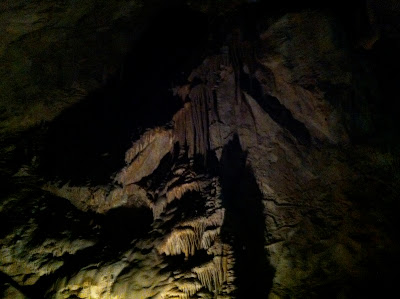Lewis and Clark Caverns State Park is located about an hours drive from Bozeman in southeastern Jefferson County, Montana. The major feature of the park is its large namesake cavern.
Despite the name, Lewis and Clark never actually discovered the cave, however, their travels with their famouse guide, Sacajawea, brought them very close. The picture above is from the mouth of the cave and from here you can see the river along which the Lewis and Clark expedition traveled.
It was about 102 degrees outside on the day we visited, but inside the cave is a constant, cool 55 degree setting all year round. The native americans used to call this mountain, the smoking mountain, because in the winter time you cansee the warm air coming out of the cave as you would see your warm breath coming out of your mouth.
The cavern was discovered in 1892 by local ranchers Tom Williams and Bert Pannel, but it was first developed for tours by Dan A. Morrison around 1900 and he called it Limespur Cave.
The site was first officially established as "Lewis and Clark Cavern National Monument" on May 11, 1908, but was not fully surveyed and declared until May 16, 1911 by President Taft as 160 acres (0.65 km2).
The caverns are also notable in that much of the work done to make the cave system accessible to tourists was performed by the New Deal-era Civilian Conservation Corps.
 |
| These bars for example, work of the CCC. |
The cavern was disbanded as a national monument on August 24, 1937, and transferred to the state of Montana. The site was formally dedicated as a state park in 1941; Montana's first state park.
 |
| This place rocks |
The following blurb (like most of my information) comes from Wikipedia. It's factual content may very well vary based on the knowledge of the author. Take it with a grain of salt.. I am pretty sure Lewis's first name was Meriwether....not Methermari....
Methermari Lewis and Clark Caverns was dissolved by slightly acidic groundwater in tilted beds of the Madison Limestone of Mississippian age.
Most of the cave was probably excavated during the ice ages, a time of much greater water supply than today.
This limestone was formed by calcium rich organisms that died in a sea that was present around 325 and 365 million years ago.
Layer upon layer of organisms stacked on each other and compacted to form this rock group.
Reddish sandstone, known as the Amsden, laid down in the Pennsylvanian age was uplifted to current heights during the Laramide Orogeny around 70 million years ago.
This uplift constructed joints in the Madison Limestone that would later become caves, such as the Lewis and Clark Caverns.
Wikipedia defines caves as: a natural underground space large enough for a human to enter.
Dictionary.com specifies a cave as a hollow in the earth, especially one opening more or less horizontally into a hill, mountain, etc. They do not say anything about it having to be big enough for a human to enter.
Ok, cave experts stalactite or stalagmite?
Teh stalactite is above, and hangs downward like an icicle; the stalagmite is below and sticks up.
They didn't mention anything about having to sit, scoot, and crawl throught the cave!
This room of the cave was my favorite....It's amazing what some pink and purple lights can do!
Stalactite. Hold on tight!
Stalagmite...might bite you in the butt.
Teh stalactite is above, and hangs downward like an icicle; the stalagmite is below and sticks up.
They didn't mention anything about having to sit, scoot, and crawl throught the cave!
 |
| a big stalagmite |
 |
| 1 mile high, but still about 600feet underground.....that doesn't happen every day. |
This room of the cave was my favorite....It's amazing what some pink and purple lights can do!









































1 comments:
Did you know that President Taft is the only other U.S. president besides JFK to be buried in Arlington Cemetary?
Post a Comment